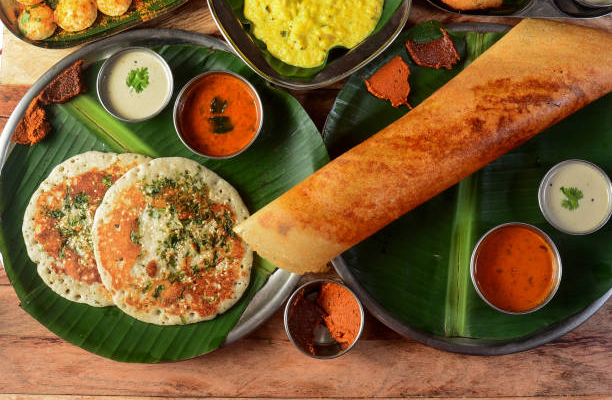A Breakfast Tour of India: 20+ Regional Dishes to Start Your Day Right
Forget cereal and toast. An Indian breakfast is a vibrant, flavorful journey across the subcontinent. From the hearty Aloo Parathas of the North to the light, fermented Idlis of the South, this guide explores over 20 iconic regional morning meals, their key ingredients, and the cultural stories behind them. Discover what makes India's first meal of the day its most diverse.
SOCIAL


In India, breakfast is not merely a meal; it is a statement. It’s a declaration that the day ahead will be met with energy, flavor, and a profound connection to local culture. Unlike the standardized breakfasts of many Western nations, India’s morning culinary landscape is astoundingly diverse, shaped by climate, history, local agriculture, and centuries of tradition.
This is a country where you can travel a few hundred miles and find an entirely new cuisine waiting for you at the breakfast table. The concept of a "national breakfast" doesn't exist here—and that’s what makes it so fascinating. From hearty, wheat-based dishes that fuel a day in the northern fields to light, rice-based, fermented foods that complement the southern heat, every region has perfected its own way to break the overnight fast.
Join us on a culinary road trip across India, exploring the most iconic, beloved, and flavorful breakfast dishes from its four corners and beyond. This is more than a list; it's an exploration of the heart and soul of Indian mornings.
North India: The Heartland of Hearty, Filling Fare
The fertile plains of North India, particularly the states of Punjab, Uttar Pradesh, and Delhi, experience colder winters and have a strong agricultural tradition. This is reflected in a breakfast culture designed for sustenance and energy. The focus is on whole wheat, hearty stuffings, rich gravies, and dairy.
Aloo Paratha: The undisputed king of North Indian breakfasts. This is a whole wheat flatbread generously stuffed with a spiced mashed potato (aloo) filling. It’s rolled out and cooked on a hot griddle (tawa) with ample ghee or butter until golden brown and deliciously flaky. Served with a large dollop of fresh white butter (makhan), cool yogurt (dahi), and a tangy pickle (aachar), it’s a complete, satisfying meal that powers people through a long morning.
Region: Punjab, Haryana, Delhi
Key Ingredients: Whole wheat flour, potatoes, spices (cumin, coriander, amchur), ghee.
Chole Bhature: A dish that is pure indulgence. It consists of Bhature—a large, soft, and fluffy deep-fried leavened bread—paired with Chole—a robust, dark-colored chickpea curry simmered with a complex blend of spices including amla (Indian gooseberry) for its signature tangy depth. It’s a popular weekend treat, street food staple, and celebratory breakfast.
Region: Punjab, Delhi
Key Ingredients: Chickpeas, refined flour (maida), yeast, spices, amla.
Aloo Poori: A simpler yet equally beloved cousin of Chole Bhature. Poori is a smaller, puffy deep-fried bread that is lighter and less leavened than Bhatura. It is served with a spicy and watery potato curry (Aloo Sabzi) that is perfect for dipping. The combination is a classic found in homes and temples alike.
Region: Uttar Pradesh, Rajasthan, across North India
Key Ingredients: Whole wheat flour, potatoes, spices, oil for frying.
Bread and Sheer Chai (Noon Chai): In the breathtaking valleys of Kashmir, breakfast takes a unique turn. Here, you’ll find local breads like Bakarkhani or Kulcha served with Sheer Chai, also famously known as Pink Tea. This traditional tea is made with green tea leaves, baking soda, milk, and salt, giving it a distinctive pink color and a savory, creamy flavor profile. It’s a warming and essential ritual in the cold climate.
Region: Kashmir
Key Ingredients: Milk, green tea leaves, baking soda, salt, local bread.
South India: The Realm of Light, Fermented, and Healthy
The tropical climate of South India has given rise to a breakfast philosophy centered on lightness, digestibility, and fermentation. Rice and lentils are the cornerstone, transformed through age-old fermentation processes into dishes that are probiotic-rich, low in fat, and incredibly flavorful.
Idli and Sambar: The quintessential South Indian breakfast known for its health benefits. Idli are soft, fluffy, steamed cakes made from a fermented batter of rice and urad dal (black gram). They are naturally gluten-free and incredibly light. They are always served with Sambar—a hot, tangy lentil-based vegetable stew—and Coconut Chutney.
Region: Tamil Nadu, Karnataka, Andhra Pradesh, Telangana
Key Ingredients: Rice, urad dal, toor dal, vegetables, coconut.
Dosa: A close relative of the Idli, made from a similar fermented batter but spread thin and cooked on a griddle into a large, crisp, golden-brown crepe. The most famous variant is the Masala Dosa, stuffed with spiced potatoes. It’s served with the same Sambar and chutneys. Its crisp texture and savory flavor are irresistible.
Region: All of South India, particularly Karnataka and Tamil Nadu
Key Ingredients: Rice, urad dal, fenugreek seeds, potatoes.
Pongal: A comforting and savory porridge made with rice and moong dal (split yellow lentils), slow-cooked with cumin, black pepper, ginger, and ghee until it reaches a soft, khichdi-like consistency. It’s a hearty yet simple dish, often offered to the gods as prasadam in temples and enjoyed at home, especially during the harvest festival of the same name.
Region: Tamil Nadu
Key Ingredients: Rice, moong dal, black pepper, cumin, ghee.
Puttu and Kadala Curry: A signature breakfast of Kerala. Puttu is a cylindrical steamed cake made from layered rice flour and grated coconut. It has a unique crumbly yet soft texture. It is invariably paired with Kadala Curry, a flavorful black chickpea curry cooked in a coconut-based gravy with warming spices.
Region: Kerala
Key Ingredients: Rice flour, coconut, black chickpeas, coconut milk.
Akki Roti: Translating to "rice bread," this is a classic from Karnataka. It’s a flatbread made from a dough of rice flour, finely chopped onions, cilantro, dill, and spices, which is then patted thin and cooked on a griddle with oil. It’s crispy, flavorful, and typically served with a variety of chutneys.
Region: Karnataka
Key Ingredients: Rice flour, fresh herbs, onions, spices.
East India: Subtle, Simple, and Deeply Traditional
The eastern states of India, like West Bengal and Odisha, have a breakfast culture that is often simpler and focuses on delicate flavors, often with a touch of sweetness or fermentation.
Luchi and Aloo Dum: A Bengali favorite, often for special occasions and Sundays. Luchi is a deep-fried, puffy bread made from refined flour (maida), similar to a poori but softer. It is served with Aloo Dum—a spicy, dry-ish potato curry in a rich, ginger-based gravy that is far more complex and flavorful than its North Indian counterpart.
Region: West Bengal, Odisha
Key Ingredients: Refined flour, potatoes, ginger, spices.
Chakuli Pitha: These are savory rice pancakes from Odisha, similar to dosas but smaller, thicker, and softer. The batter often includes black gram and is left to ferment slightly. They are a staple breakfast item, served with jaggery or potato curry.
Region: Odisha
Key Ingredients: Rice, black gram, curd.
Radhaballabhi and Cholar Dal: A classic Bengali combination. Radhaballabhi is a soft, slightly sweet, deep-fried bread made from refined flour and stuffed with urad dal. It is paired with Cholar Dal—a sweet and savory Bengali-style chana dal (split chickpeas) cooked with coconut, raisins, and spices.
Region: West Bengal
Key Ingredients: Refined flour, urad dal, chana dal, coconut.
Panta Bhat: A testament to the no-waste culture. It is cooked rice soaked in water overnight and allowed to ferment slightly. Eaten the next morning, it has a cooling effect on the body, making it perfect for hot summers. It’s typically served with raw onion, green chili, a dash of mustard oil, and sometimes fried fish.
Region: West Bengal, Assam, Odisha
Key Ingredients: Leftover rice, water, mustard oil, onion.
West India: A Symphony of Spices, Sweetness, and Crunch
The western states offer a incredible contrast, from the spicy street food of Maharashtra to the sweet-and-sour flavors of Gujarat.
Poha: Perhaps the most popular breakfast across Maharashtra and Madhya Pradesh. It is made from flattened rice (poha) that is rinsed and then sautéed with mustard seeds, cumin, turmeric, onions, peanuts, and curry leaves. Finished with a squeeze of lemon and fresh cilantro, it’s a light, quick, nutritious, and utterly delicious dish.
Region: Maharashtra, Madhya Pradesh
Key Ingredients: Flattened rice, peanuts, turmeric, lemon.
Thepla: The ultimate travel breakfast from Gujarat. These are soft, thin flatbreads made from whole wheat flour, besan (gram flour), and fresh fenugreek leaves (methi), spiced with turmeric, chili, and sesame seeds. They stay soft for days and are typically enjoyed with a dollop of pickle or yogurt.
Region: Gujarat
Key Ingredients: Whole wheat flour, gram flour, fenugreek leaves, spices.
Khaman Dhokla: A famous Gujarati steamed snack that also doubles as a breakfast. It’s a fluffy, savory, and slightly sweet cake made from fermented chickpea flour. Tempered with mustard seeds and curry leaves and garnished with coconut and cilantro, it’s a healthy, protein-packed, and tangy start to the day.
Region: Gujarat
Key Ingredients: Chickpea flour, fruit salt (eno), yogurt, tempering.
Misal Pav: For those who like a fiery start. Misal is a spicy curry made from sprouted moth beans (matki), topped with crunchy farsan (fried savory mix), onions, cilantro, and a squeeze of lemon. It is served with soft bread rolls (Pav). It’s a flavor and texture explosion that is uniquely Maharashtrian.
Region: Maharashtra
Key Ingredients: Sprouted moth beans, farsan, spice blend, pav.
Hidden Gems: Special Regional Treats
Beyond the major regions, India has countless unique breakfast specialties.
Sattu Paratha (Bihar): A power-packed flatbread from Bihar, stuffed with sattu (roasted chickpea flour) mixed with spices and herbs. It’s incredibly nutritious and provides sustained energy.
Sarva Pindi (Telangana): A savory, crispy rice flour pancake cooked with peanuts, sesame seeds, and chopped onions, traditionally made in a copper pan.
Aloo Gutke (Uttarakhand): A simple but fiery dish of boiled potatoes tempered with local mountain spices like jakhya and red chilies, eaten with mandua (finger millet) or wheat rotis.
Fara (Chhattisgarh): Steamed rice dumplings similar to modak, often stuffed with a spicy lentil filling and served with a fiery green chutney.
